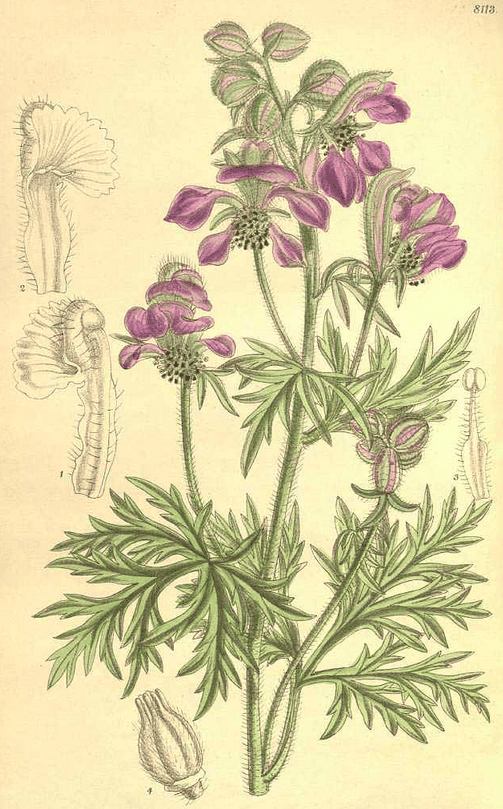Aconitum naviculare, Bong nga dmar po བོང་ང་དམར་པོ
Red Aconite, ‘Bang Ga’Bong nga dmar po, Bong dmar (Tibetan Medicine)
Gan Qing Wu Tou (A. tanguticum, TCM)
Chuan Kui Wu Tou 船盔乌头, Wu Tou Zhou Gu 乌头舟骨

 Aconitum gymnandrum
Aconitum gymnandrum‘Red Aconite’ (Lesser variety)
Curtis’s Botanical Magazine (1907)
Botanical name:
The first two listed are the primary species supply this medicine in Tibetan Medicine, the latter are mentioned by some sources:
Aconitum spp:
- A. naviculare (Tibet. Sichuan, Gansu, Qinghai)
- A. tanguticum (Sichuan, Gansu, Qinghai, Tibet)
- A. gymnandrum (Lesser variety) (‘dzin pa zla bral)
- A. liangshanicum (is regarded as synonymous to A. tanguticum in TCM texts)
- A. creagromorphum
- A. pulchellum
- A. lycoctonum
Parts used:
Whole plant (herb with root), or aerial parts
Temperature & Taste:
Cool, dry. Bitter. Slightly Toxic
Constituents:
A. NAVICULARE: Alkaloids: Navirine
Uses:
1. Clears Wind-Heat, Resists Poison:
-used for Poisonous plants and Animal Venoms
-Food Poisoning, especially Meat poisoning–Gastroenteritis
-Contagious and Epidemic Fevers; Small Pox, Measles
-Cold or Influenza with Fever
-Headache, Toothache
2. Clears Heat, Stops Cough:
-Acute Sore Throat, Pharyngitis, Laryngitis
-Cough, Bronchitis
-Pneumonia
3. Clears Heat and Damp:
-Gastritis; Enteritis, Dysentery
-Bile disorders; Jaundice
-Hepatitis; Cholecystitis
-Hypertension (Nepal)
Dose:
600–1200mg (typically 1 gram)
Half teaspoon of powdered herb is mixed with 2 teaspoonfuls of Ghee, taken twice daily for Fever and Jaundice in Nepal.
One gram is boiled in 2 glasses of water down to half. This is taken twice daily.
Comment:
Aconitum naviculare is endangered due to over harvesting.
Main Combinations:
1. Cholecystitis, acute Jaundice, Hepatitis, Aconitum naviculare, Swertia, Picrorhiza, Barberry bark, Costus
2. Hepatitis:
i. Aconitum naviculare, Swertia, Triphala, Tinospora, Picrorhiza, Rhubarb
ii. Aconitum naviculare, Sandalwood, Chebula, Safflower, Tabasheer, Emblic Myrobalan, Swertia, Costus
3. Influenza, with runny nose, headache, body aches, Aconitum naviculare with Chebula, Costus, Inula, Swertia, Calamus, Tinospora, Bezoar
4. Heat-type Cough with Fever, shortness of Breath, Aconitum naviculare with Sandalwood, Tabasheer, Safflower, Licorice, Adhatoda, Inula, Triphala (as in 25 Taste Lung Disease Powder of Tibetan Medicine)
5. Heat-type Cough, Pneumonia in children, Aconitum naviculare with Tabasheer, Safflower, Rhodiola, Sandalwood, Picrorhiza, Licorice, Bezoar
Major Formulas:
Rin Chen Mang Jor
Rin Chen Dang Jor Ril Nak Chen Mo
Rin Chen Chak Ril Chen Mo
Turquoise 25
Cautions:
Avoid overdose
Main Preparations used:
-
Extra Info
- Research
–[HPLC fingerprint of Tibetan medicinal plant ″Bangga″ and chemical components analysis of its two original plants by LC-MS/MS].
–[Resources and usage status of Tibetan medicinal plant “Bangga”].
–Alkaloids from Aconitum tanguticum
–[Chemical constituents from whole plants of Aconitum tanguticum (III)].
–[Chemical constituents from whole plants of Aconitum tanguticum].
–[Chemical constituents of Aconitum tanguticum].
–Herbal Textual Research on Tibetan Medicine” Bangga”
ACUTE LUNG INJURY
–The total alkaloids of Aconitum tanguticum protect against lipopolysaccharide-induced acute lung injury in rats.
ANTI-ARRHYTHMIC
–6-Benzoylheteratisine – a class-I antiarrhythmic substance from Aconitum tanguticum (Maxim.) Stapf.
CANCER
–Navicularines A-C: New diterpenoid alkaloids from Aconitum naviculare and their cytotoxic activities.
